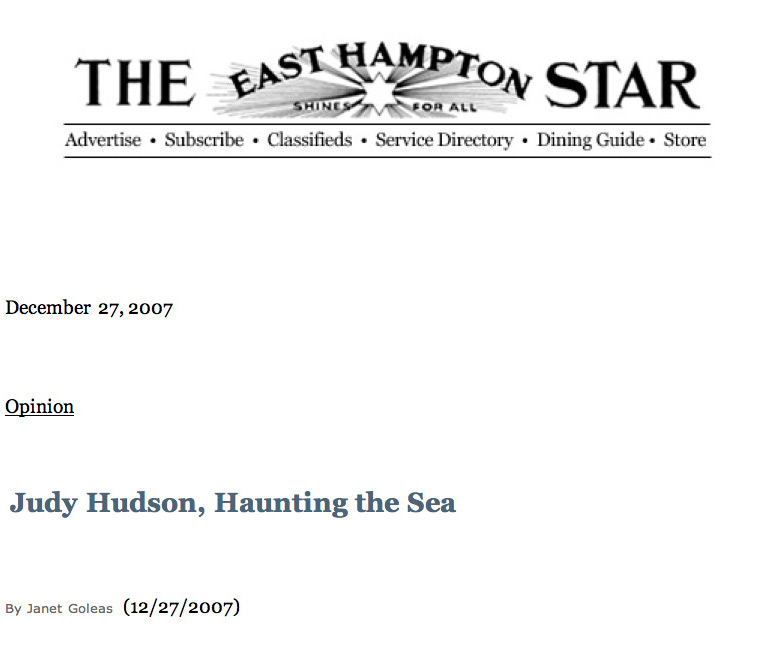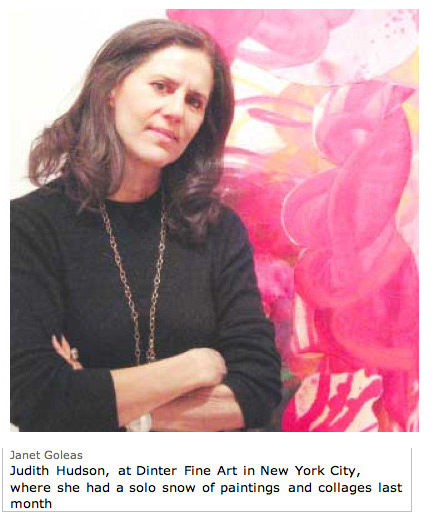 |
It takes a long time to get to be good at painting. If you live long enough, by the time you really hit your stride, you’ve weathered at least three or four art storms in which painting has been pronounced dead or at the very least anachronistic, largely deflated, or just plain immaterial. It is a special triumph when a gifted abstract painter like Judith Hudson proves that the medium is alive and well, as she did with a rousing show of new paintings that opened last month at Dinter Fine Art in New York City. |
 |
But that’s
not all. In one of those rare, fortune-cookie moments of double happiness, the
exhibit coincided with the publication of her first limited-edition artist’s
book, “Flying Dutchman.” The hand-printed, hand-bound book juxtaposes Ms.
Hudson’s dazzling imagery and original paintings with the explosive prose of
her husband, screenwriter and novelist Richard Price.
On a
cold, clear day earlier this month, Ms. Hudson, 61, a slim, leggy brunette, sat
down in the gallery. Framed by her work, she talked about her art,
collaborating with her husband, and the special role the East End plays in
their lives. They’ve have had houses here for more than 30 years, beginning on
North Haven, then Shelter Island, and most recently they moved from East
Hampton to a new house in Amagansett.
The house
sits on Napeague Bay; its floor-to-ceiling windows look out on a sandy crescent
of beach that stretches as far as the eye can see. “I grew up on Cape Cod,” Ms.
Hudson said. “I was so happy there that I always longed for that time.”
She said
the house on Napeague brought back those childhood memories and that moving there
felt something like a homecoming. “It completely satisfied that longing,” she
said.
On
Napeague the artist paints in a studio of her own design. It is filled with
light, but with windows dramatically placed above eye level; the dynamic water
views are not a distraction.
The
couple met in a scene straight from a 1980s Woody Allen movie. “An old
boyfriend came to New York and looked me up,” Ms. Hudson recalled. “We got
together for dinner, and that’s when I met Richard.”
Eight
months passed before the two met again, quite by accident. “I was walking down
the street and I ran into him. I often think, if I had taken longer to tie my
shoe that day my entire life would be different.” In a persuasive case for the
belief in love at first sight, the couple have been together ever since, and
have two children.
Mr.
Price, who wrote the semiautobiographical novel “The Wanderers” when he was
just 20 years old, met with early and continuing success. The critically
acclaimed book was released in 1974, and by 1979 it was a major motion picture.
“His voice
just came booming out,” said Ms. Hudson. “He always had an overwhelming
understanding of the collective unconscious. Richard’s a natural
talent.”
“Flying
Dutchman” is a special-edition art book published by Carpe Diem Press, which
fuses Ms. Hudson’s art with selected prose from Mr. Price’s upcoming novel, to
be released in March, “Lush Life.
In
folklore, the Flying Dutchman is a ghost ship destined to haunt the seas for
eternity. The legend has spurred countless adaptations, from Wagner’s famed
opera to Albert Pinkham Ryder’s turbulent seascape, both of the same name. Like
the fusion here between husband and wife, the legendary tale has links in both
the literary and visual worlds.
“Lush
Life” depicts contemporary New York City —gentrified and clean —
but not lacking a dark underbelly of seething criminality and violence. Weaving
through the details of a robbery gone bad, Mr. Price takes a spin through the
gritty streets of Manhattan’s Lower East Side.
Focused
through the lens of a homicide investigation, Mr. Price’s trademark dialogue is
incisive and poetic. It not only
selected the
passages from his manuscript for inclusion in “The Flying
Dutchman.”
Each copy
of “Flying Dutchman” — there are only 35 — is different. Ms.
Hudson’s illustrations are stunning and volcanic, and the combination of
original paintings and one-of-a-kind literature is sublime.
Luscious
spirals erupt across the front, slipping inside folds, diving around back, and
swelling in and out of focus. “I wasn’t illustrating “Lush Life,” but I did
intuit Richard’s process. It was like I was the spiritual ghost that followed
him down the street,” she said.
Mr.
Price, 58, a compact man, bristling with energy, concurred with his wife, during
a weekend alone at his house in Amagansett. “Judy worked the connection between
the endless honeycombing of the streets with her own hypnotic swirls and
loops,” he said. “It was a terrific abstract visualization of how it must feel
to be the characters prowling this urban labyrinth hour after hour. Bio-jazz.”
The prose
is fiery and alive. Pressed into the thick handmade paper, the words have a
physical presence. In contrast to his usual darkly funny, vernacular delivery,
here the words are lyrical. “Richard’s work is lush and poetic. Even though
it’s about the street, it has swirling, exotic layers,” the artist
said.
The book
evolved through Ms. Hudson’s long friendship with the artist James Brown. In
1995, Mr. Brown and his wife, Alexandra, moved to Oaxaca, Mexico, where they
began producing limited-edition books. Their publications incorporate old metal
and wood typefaces and handmade bindings that reflect the traditions of Mexican
artisans.
For
“Flying Dutchman,” Mr. Brown selected typeface that is a hybrid of antique
printing blocks. On the colophon and title pages, he paired fonts distinctive
of the old West with curly Victorian serifs for an amalgamation approximating
the Chinese, Jewish, and Puerto Rican immigrants who line the streets of
Manhattan’s Lower East Side where “Lush Life” is set.
Ms.
Hudson’s show at Dinter Fine Art shimmers with verve and candor. The work,
which can be seen by appointment through Jan. 10, and online at
www.dinterfineart.com, sparkles with kinetic energy. The large canvases are
volatile and fantastical, with luminous, watery filigrees pulsing across the
surface, moving the eye between flatness and illusions of deep
space.
Their
liquidity poses a powerful metaphor that revolves around cause and effect.
Defined by the insistence of water, one feels the power of natural order here,
as if the seepage and swirling of Ms. Hudson’s marks were somehow
inevitable.
The
amorphous, watery world created in the paintings seems infinite through the
introduction of a mirrored strip that lines the circumference of each frame. It
gives the illusion of an infinite repetition of pattern and color. “I wanted a
sort of access into the unconscious,” Ms. Hudson said. “I’m interested in the
physical and metaphysical—macrocosms and microcosms.”
Many of
the paintings were done in Ms. Hudson’s studio on Napeague. It is a place Ms.
Hudson and her husband come to work, rest, and recharge while contemplating the
mutable nature of the watery view.
“I come
out in the cold months and get into a work-trance that is hard to duplicate in
the city,” said Mr. Price. “We’re both artists but in different forms. We have
the same bottom line — a sympathetic shorthand about what’s important,
but enough distance from each other in our respective arenas not to make each other
nuts.”
Isn’t love grand? |